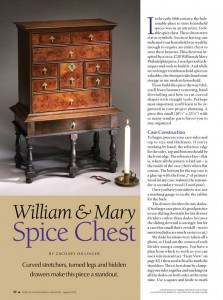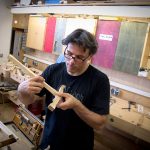We may receive a commission when you use our affiliate links. However, this does not impact our recommendations.
 In our August 2013 issue, you’ll find a William & Mary Spice Chest built by Michigan woodworking Zachary Dillinger. It’s a lovely little project with lots of surprises (including an ingenious way to connect the top and bottom pieces as well as hidden drawers), and the article is chock-full of hand-tool instruction (though of course, it can also be built using tailed tools).
In our August 2013 issue, you’ll find a William & Mary Spice Chest built by Michigan woodworking Zachary Dillinger. It’s a lovely little project with lots of surprises (including an ingenious way to connect the top and bottom pieces as well as hidden drawers), and the article is chock-full of hand-tool instruction (though of course, it can also be built using tailed tools).
Zach shows you step by step how to build it, discusses important considerations for hand-tool use and shares his finish recipe that adds 280 years in just a couple of coats (OK – there are perhaps more than a couple…but shellac dries quickly).
But what we didn’t put in the magazine (and what I didn’t know until he brought the piece to Cincinnati so our photographer, Al Parrish, could take the opener shot) is that after Zach completed this gorgeous piece of furniture, he pretty much beat the heck out of it to make it look as if it has survived almost three centuries of use. While you can’t see the simulated wear and tear in the small picture, it’s immediately evident up close and in person.
While I’m not privy to his entire destructive process, I recall Zach saying that he deliberately knocked off at least one moulding piece with a hammer, then reapplied it. He willfully chipped corners on the burl walnut veneered drawer fronts. And the “slack” drawers simulated not only period practice, but drawers that had been pulled out and pushed in for many decades.
While I’ve taken a chain and keys to a couple I Can Do That projects over the last eight years, those are all uncomplicated projects built with inexpensive wood and just a few hours’ shop time – which is not to say they don’t look good, but they are a great deal less labor and resource intensive than a dovetailed walnut chest with nine veneered drawers (along with the non-veneered lower drawer and the hidden drawers), turned legs, curved stretchers and the like.
I just don’t think I could bring myself to go Conan on a project of that magnitude. Could you? Let me know in the comments (because I can’t get our &*%$ poll plugin to work).
p.s. Eli Cleveland, who works with Thomas MacDonald on the WGBH show “Rough Cut: Woodworking with Tommy Mac,” is a funny guy. This little chest looks the same as a well-known full-sized William & Mary form, so we needed a way to indicate its scale without cluttering up the shot. We thought the candle did that, but Eli said, “That candle is HUGE!” I suppose he could be right.
Here are some supplies and tools we find essential in our everyday work around the shop. We may receive a commission from sales referred by our links; however, we have carefully selected these products for their usefulness and quality.










I have to respect Zach’s choice. After all, he built it. I’m too cheap to bring myself to do something similar to expensive wood and veneers. I tend to seek perfection when I build a piece but that means different things to different people and if Zach considers this the “perfect finish” then more power to him. Still, I don’t think I could bring myself to do it.
No way ,. If I had the talent, time and expertise to produce a piece of furniture of this extreme quality., I would likely have chromed columns with red velvet ropes around it, and whoa be the person who damaged it. I would distress a kindling box that I had built for my fireplace,, maybe. Sorry,, but if you want a newly created heirloom to look like an antique, then go buy the original.
Best, Mike O’Brien
Valley Head, AL
I never intentionally distress anything I make. I have 5 kids though. It will be distressed in no time.
I knew a guy who did this with butter molds and other small items. He then would consign them to an auction, making no claims that they were antique, but also not admitting that he had made and distressed them. They brought good sums – people thought they were buying authentic antiques. Fraud or giving the customer what they want?
Just because he was a lousy Tonight Show host why do you assume Conan would build a beat up piece of furniture? Maybe he’s a better woodworker than a talk show host.
Sorry, Megan…I should have said EVER since then!
I became interested in woodworking through an older neighbor who could do almost anything but furniture restoration was his specialty. He asked me to go with him once to pick up and deliver an antique for one of his clients. This lady was in her 80s and she had sold an armoir to a wealthy client. I was shocked when she took out a ball peen hammer and went to work on the armoir’s legs and then she used a chain to beat up on the skirt. I’ve wondered about antiques every since then!
I can’t think of a reason for “distressing” a freshly-built piece other than to introduce deception about the history of the piece. It’s true that this deception is common among furniture manufacturers and so may not be very deceptive in fact. It is also common among those who would pass off a rebuilt piece as an original. I wouldn’t buy or build a piece that had been artificially aged.
Everything I build already looks distressed.
Come to think of it, i walk in a room and everyone looks distressed…
I wonder if there’s a connection?
Best regards,
Albert A Rasch
I hate 107s, I really do.
I guess I’m not a big fan of distressing. I prefer my furniture to come by it’s aging honestly. I could never take a hammer to nice piece.
Distressing has a place if the purpose of the build is to match a true antique.
Otherwise, I believe the new build should look new. Did the person who built the original then set about whacking the snot out of it with a chain?
I ‘get’ both camps. I have an antique mahogany table that I would not touch a thing on. If I built a reproduction, I’d want it to stay as new as possible. If I built a reproduction meant to sit across the room from the original, I’d distress it.
I’m personally not a fan of artificially aging furniture. I once saw a show on television where a couple must have spent close to $100,000 on kitchen cabinets only to “distress” them using mallets and keys and hammers in order for the cabinets to fit in with their newly constructed farmhouse that they wanted to look old. I thought it was pretty ridiculous myself but to each his own. I think if you want your furniture to look old you should buy an antique, otherwise let your furniture obtain its character naturally by using it.